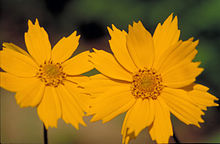- Coreopsis auriculata
-
Mouse-ear Tickseed 
Scientific classification Kingdom: Plantae (unranked): Angiosperms (unranked): Eudicots (unranked): Asterids Order: Asterales Family: Asteraceae Genus: Coreopsis Species: C. auriculata Binomial name Coreopsis auriculata
Linnaeus.Coreopsis auriculata (Mouse-ear Tickseed) is a plant species of the genus coreopsis in Asteraceae. Coreopsis species are commonly called Tickseeds. This species is perennial growing from 10–30 cm (4-12 inches) tall and sometimes to 60+ cm (30 inches). Pants with rounded yellow colored flowers bloom in spring and early summer. They are often stoloniferous, forming long spreading colonies by way of short stolons produced after flowering. Plants produce both basal and cauline leaves; the foliage occupy 1/4–1/2 of the plant height, the leaves have petioles 1–6(–10+) cm long, with simple leaf blades or they sometimes have 1 or 2, or more lateral lobes. The basal leaf blades are suborbiculate or ovate-elliptic to lance-ovate in shape and typically 15–55 mm long and 9–25 mm wide. Flower heads are produced on the ends of 8 to 25 cm long peduncles, the heads have 9–12 mm long phyllaries that are lance-deltate to lance-ovate in shape. The flower petals or more properly the ray laminae are yellow colored and 15–20+ mm long. The disc flowers have corollas 3.5–4.5 mm long with yellow colored apices. Cypselae or the fruits containing a single seed are 1.5–2.5 mm long and brown black in color with no wings.[1]
Plants are found growing along roadsides and in openings in woods with mixed hardwood trees and pine barrens especially with calcareous soils in the south eastern USA. Coreopsis auriculata 'Nana' is commonly grown as a blooming ground cover in garden settings.
An orange to red/orange dye produced from the flowers and stems has been used in the past.[2]
References
- ^ Coreopsis auriculata in Flora of North America @ efloras.org
- ^ Grae, Ida. 1974. Nature's colors; dyes from plants. New York: Macmillan. ISBN 0-02-544950-8

This Heliantheae article is a stub. You can help Wikipedia by expanding it.
